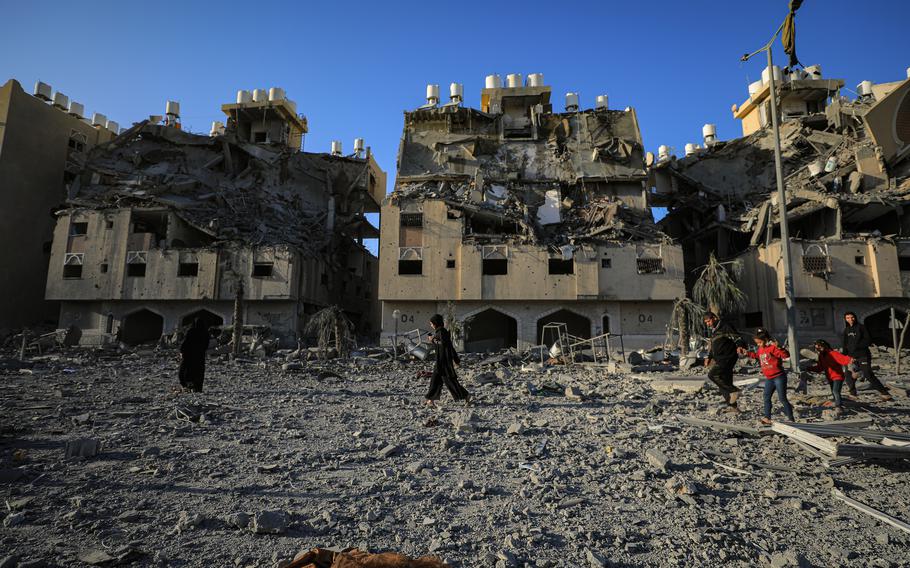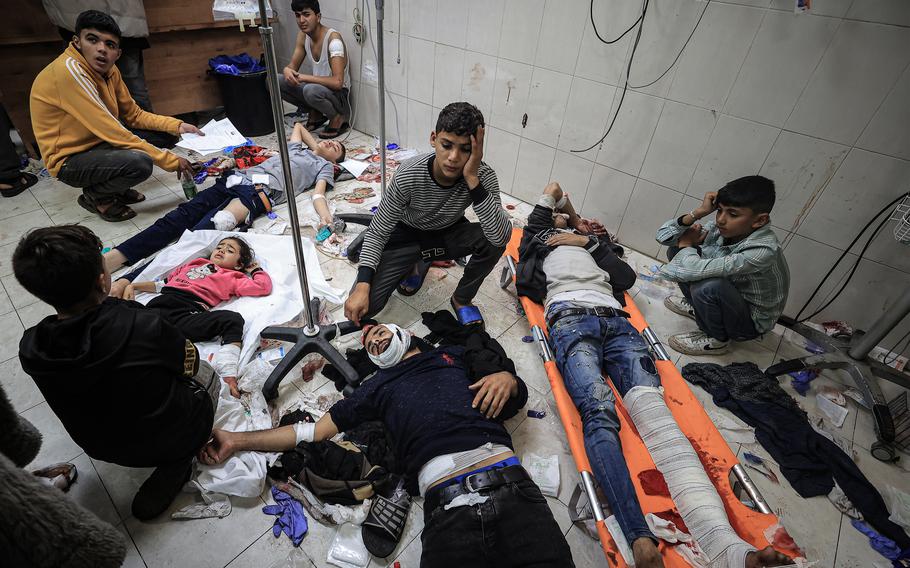Middle East
What is happening in Gaza’s Khan Younis, as Israel’s offensive heads south
The Washington Post December 12, 2023

Residents leave the Hamad Towers area of Khan Younis on Dec. 2, 2023, after Israeli attacks. (Loay Ayyoub/for The Washington Post)
Israel’s offensive in Gaza has increasingly shifted to the south, with its forces pushing last week into Khan Younis, a major southern city that had provided refuge for Palestinians displaced from the north.
Over the weekend, Israeli tanks and troops moved into the center of Khan Younis, and the Israel Defense Forces claimed that it struck underground tunnels in the city. Describing Khan Younis as one of Hamas’ strongholds, IDF spokesman Rear Adm. Daniel Hagari called it one of the places where his troops are fighting “fierce and difficult battles.”
Here is what to know about Khan Younis and the fighting taking place there.
Where is Khan Younis and how many people live there?
Khan Younis, north of the Rafah border crossing, is the largest city in southern Gaza. It was home to about 400,000 people before the war.
It houses civilian infrastructure, such as the Nasser Hospital, and is also the site of one of eight U.N. camps for Palestinian refugees who had to leave their homes in the 1948 war. The Khan Younis refugee camp, with about 88,854 registered refugees, is overcrowded and most of the camp’s water supply is unfit for drinking, according to UNRWA, the United Nations agency for Palestinian refugees.
Khan Younis was the site of a massacre in 1956 when Israeli forces attacked Gaza, killing dozens of refugees, according to a U.N. report. Israeli authorities said Palestinian refugees were part of the resistance, a charge the Palestinians denied, the report said.
After the war that began on Oct. 7 of this year, Khan Younis became a major destination for fleeing Palestinians, and was crowded with displaced civilians following IDF’s directive to evacuate to the south. But now, the city once considered safe is the site of some of the heaviest fighting.
Why is Khan Younis significant?
Khan Younis has been linked to Yahya Sinwar, the leader of Hamas in the Gaza Strip. Sinwar was born in the Khan Younis refugee camp in 1962 and some Gazans have dubbed him the “Butcher of Khan Younis.”
At the top of Israel’s hit list in Gaza, Sinwar is accused of masterminding the Oct. 7 Hamas attack on Israel that killed at least 1,200 people. Israeli officials claim Sinwar and other key leaders are hiding out in the south.

Injured Palestinians arrive at Nasser Medical Hospital on Dec. 5, 2023, after a UNRWA school housing displaced people in Khan Younis was targeted. (Loay Ayyoub/for The Washington Post)
Israeli Prime Minister Benjamin Netanyahu urged Hamas fighters to surrender and abandon their leaders. “It’s over. Don’t die for Sinwar. Surrender now,” he said in a video statement Sunday.
The city has a rich cultural history which is now under threat amid bombardment. The town square is bordered by a fortress dating back to Egypt’s Mamluk rulers from the 13th century.
What is happening now in Khan Younis?
In the past days, IDF has said there are fierce fights ongoing in several Hamas strongholds simultaneously: Shejaiya and Jabalya in the north and Khan Younis in the south.
On Dec. 10, the IDF said it used “precise munitions” to strike underground tunnel shafts in Khan Younis and used a drone to identify and eliminate “an armed terrorist cell” in Khan Younis.
Over the last week, Israel has called for the evacuation of parts of Khan Younis, sending displaced civilians on the move once again; but Palestinians say there is nowhere left to go.
On Dec. 6, five U.N. schools where people were sheltering in the Khan Younis region were forced to evacuate after Israeli orders, the United Nations Office for the Coordination of Humanitarian Affairs said in a statement. And on Dec. 10 and 11, al-Amal Hospital in Khan Younis witnessed repeated bombardment in its vicinity, the agency said Monday.
Strikes have hit areas of Khan Younis that civilians had imagined would be safe, including a strike on a school that killed and injured dozens of displaced people on Dec. 5.
“They told people to leave Gaza City and come to Khan Younis. ... We were supposed to be in the unthreatened areas,” Mohammed al-Majayda, who was living in Khan Younis during strikes last week, told The Washington Post. Many people sheltering near him had arrived to the southern city just a day before strikes hit, Majayda said. “They should have given a warning that they would strike this building,” he said, covered in rubble dust. He had to carry his elderly uncle who “couldn’t walk or move” to safety, he said.